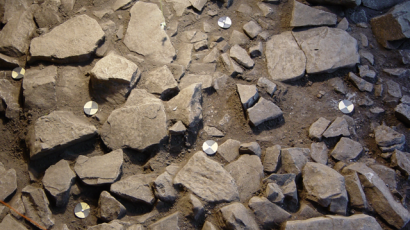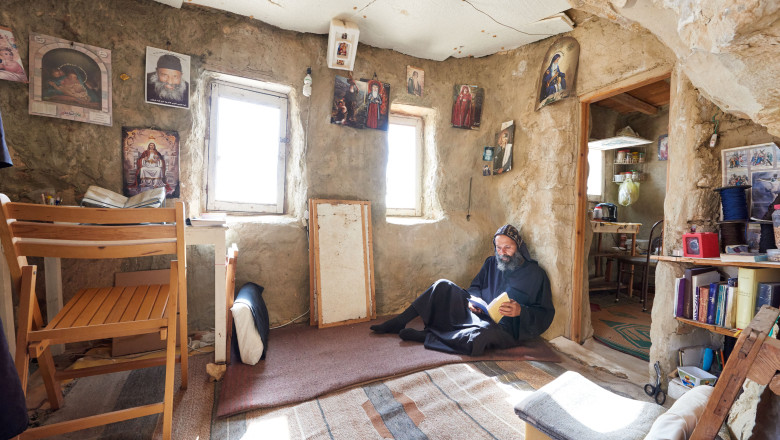
© Faculty of Arts, University of Ljubljana | All rights reserved.
Accessibility Cookies Privacy Policy
Design and development: ENKI

Matjaž Kačičnik 2018 © Endangered Hermitages Project = Documenting Coptic Monastic Heritage Project
Principal investigator: Jan Ciglenečki
Endangered Monastic Heritage and the Initiative for Its Documentation
The project “Documenting Coptic Monastic Heritage” (DCMH) is a collaborative undertaking between the Faculty of Arts, University of Ljubljana, and the Institute for Monastic Studies and Contemplative Sciences. The beginnings of the project date back to the period between 2018 and 2019. During this time, the American Research Center in Egypt (ARCE) allocated funding from its Antiquities Endowment Fund to the project “Endangered Hermitages: Documenting Coptic Heritage in Middle Egypt and in the Eastern Desert” (under its original title) for the urgent photographic documentation and survey of critically endangered monastic sites in the broad regions of Middle Egypt and the Eastern Desert.
The starting point of the documentation work was a compilation of notes by the French priest Maurice Martin, titled “Monastères et sites monastiques d'Égypte”, which was posthumously published by the Institut Français d’Archéologie Orientale (IFAO) in 2015. Our objective was to locate, revisit, and create a basic photographic record of the monastic sites listed by Maurice Martin, many of which are today not well known, inadequately documented, and often difficult to access. Our visits to these sites enabled us to conduct preliminary photo documentation, assess their overall state of preservation, and identify imminent threats to the archaeological remains.
Since the very start of our documentation work, it has become increasingly evident that numerous historically important sites listed in Maurice Martin’s notes are severely endangered today. During our field surveys, we have outlined a typology of these threats, which can be succinctly classified into three main categories: a) Damage due to plundering and unauthorized digging; b) Destruction from various infrastructural projects, and c) Damage as a result of improper management of cultural heritage. Based on our experiences across various regions of Egypt, we can conclude that despite the revival of Coptic monasticism in recent decades, the architectural heritage of monasticism in Egypt is currently witnessing one of its most challenging periods in history.
In numerous cases, our documentation and survey efforts were simply unable to keep up with the rapid destruction caused by various segments of the community, ranging from large-scale investors to local residents. Bedouins, tourists, pilgrims, and at times even the monastic communities themselves contribute to the trend, often unaware of the extent of the damage they cause. A persistent threat is the deliberate looting of antiquities, which has been a growing problem in the past two decades. Recent studies have shown that illegal digging strongly correlates with the decline of tourism, as this results in socio-economic instability for local communities, forcing many affected by poverty to turn to looting.
The preservation of Egypt's monastic heritage is contingent upon a variety of local and global factors, necessitating our prompt and decisive response to these evolving challenges. Recognizing our role in addressing this broader issue, we are actively contributing by creating a comprehensive repository of photographic documentation. This endeavour aims to ensure that there is at least a basic photographic documentation available for as many of these monuments as possible, thereby preserving a record of them for future generations.
DCMH Photographic Archive
The Egyptian monastic tradition is a rich and shared legacy that belongs to all of humankind. It was a privilege, made possible by ARCE’s generous Antiquities Endowment Fund grant, to be an active player in its preservation.
The most significant outcome of the project activities in the period between 2018 and 2019 is the gathered data. On one hand, the project has produced the largest high-quality photographic archive of monastic monuments in the Eastern Desert, along the Red Sea coast, and in parts of Middle Egypt. On the other hand, it has contributed extensive new information regarding the general archaeological context of many monastic sites, some of which are little known and have only been briefly documented in the past. Both of these outcomes serve as indispensable tools for assessing the extent of damage experienced by these sites in recent decades and for facilitating further, more detailed archaeological research into them in the future.
Following the hiatus caused by the global Covid-19 crisis and the subsequent suspension of fieldwork in Egypt for almost two years, the project resumed under the auspices of the Faculty of Arts, University of Ljubljana, and the Institute for Monastic Studies and Contemplative Sciences in 2022. The initial photo archive, compiled during the first field seasons, continues to expand beyond Middle Egypt and the Eastern Desert to various regions across Egypt.
In collaboration with partner institutions (in progress) in Slovenia (Heritage Science Laboratory Ljubljana at the University of Ljubljana) and in Egypt (Ain Shams University, Cairo University, Bibliotheca Alexandrina), along with foreign archaeological missions working in regions rich in monastic heritage, our objective is to comprehensively cover as many sites as possible. This includes assessing their current state of preservation and providing basic photographic documentation of their monastic remains. In addition to the photographic archive housed at the Faculty of Arts, University of Ljubljana, we are continually comparing the existing collection by researching old photographs kept in scattered archives in Egypt, Europe, and the USA.
The “Documenting Coptic Monastic Heritage” (DCMH) initiative will facilitate our efforts to identify the damage and destruction that Egyptian monastic heritage has faced over time. A consortium of the aforementioned partners, led by the Faculty of Arts (University of Ljubljana) and the Institute of Monastic Studies and Contemplative Sciences, will seek additional funding to conduct the planned research activities. We warmly invite institutions and researchers interested in collaborating on this mission to join us.
DCMH Team
dr. Jan Ciglenečki (Faculty of Arts, University of Ljubljana; Institute for Monastic Studies and Contemplative Sciences, Slovenia), Assist. Professor of Ancient and Medieval Philosophy and Researcher in Coptic Studies
dr. Abdelrazek Elnaggar (Faculty for Chemistry and Chemical Technology, University of Ljubljana, Slovenia, and Ain Shams University, Egypt), Senior Scientific Counsellor and Heritage Science Expert
dr. Atef M. Abdel-Hamid (Department of Geography, University of Cairo, Egypt), Associate Professor of Geography and Desert Topographer
dr. Urška Furlan (American Research Center in Egypt, Egypt), Egyptologist
Žiga Smolič (Faculty of Arts, University of Ljubljana, Slovenia), Historian and Video Documentarian
Mateja Ravnik (Institute for the Protection of Cultural Heritage), Archaeologist and Conservator
Student assistants:
Tadeja Novak (Faculty of Arts, University of Ljubljana, Slovenia), Photo Archive Assistant
© Faculty of Arts, University of Ljubljana | All rights reserved.
Accessibility Cookies Privacy Policy
Design and development: ENKI